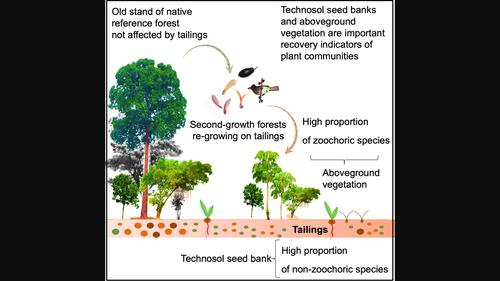当前位置:
X-MOL 学术
›
Ecol. Res.
›
论文详情
Our official English website, www.x-mol.net, welcomes your feedback! (Note: you will need to create a separate account there.)
Seed bank and aboveground vegetation of Atlantic Forest re‐growing on mining tailings in Mariana: Highlighting diversity patterns of functional groups
Ecological Research ( IF 2 ) Pub Date : 2024-03-21 , DOI: 10.1111/1440-1703.12453 Sebastião Venâncio Martins 1 , Aline Pilocelli 1 , Gabriel Correa Kruschewsky 2 , Andreia Aparecida Dias 2 , Fabio Haruki Nabeta 2 , Pedro Manuel Villa 1
Ecological Research ( IF 2 ) Pub Date : 2024-03-21 , DOI: 10.1111/1440-1703.12453 Sebastião Venâncio Martins 1 , Aline Pilocelli 1 , Gabriel Correa Kruschewsky 2 , Andreia Aparecida Dias 2 , Fabio Haruki Nabeta 2 , Pedro Manuel Villa 1
Affiliation

|
Natural regeneration after mining activities depends largely on the soil seed bank (SSB) and aboveground vegetation (AGV) richness and composition. We evaluated the species diversity pattern of the SSB and AGV on soil and technosol across second‐growth Atlantic Forests (SGFs) after mining tailings deposition in Mariana, southeastern Brazil. Two second‐growth Atlantic seasonal semideciduous forests of different stand ages were selected: a 3‐year‐old stand of SGF re‐growing on tailings (SGF tailings) and a 30‐year‐old stand of native reference forest not affected by tailings (SGF nontailings). Overall, the results showed significant differences in forest attributes (species richness and composition) in the SSB and AGV between the two forest patches evaluated (SGF tailings and SGF nontailings). Moreover, both nonzoochoric and zoochoric dispersed species of AGV showed significant differences between second‐growth forests, with higher variability of community‐weighted mean in SGF tailings. The result shows smaller differences in species richness between forest types for both SBB (ranging 85 and 90 species) and AGV (~55 species). Despite the time difference between the secondary forest and the absence of zoochoric species in the tailings seed bank, the AGV that are re‐growing on mining tailings presented a high proportion of zoochoric species. This pattern of species richness and community composition variability observed in the technosol seed bank, and AGV that are re‐growing after the deposition of mining tailings are important recovery indicators for plant communities affected.
中文翻译:

马里亚纳尾矿上重新生长的大西洋森林的种子库和地上植被:突出功能群的多样性模式
采矿活动后的自然更新很大程度上取决于土壤种子库(SSB)和地上植被(AGV)的丰富度和组成。我们评估了巴西东南部马里亚纳采矿尾矿沉积后二次生长大西洋森林 (SGF) 土壤和技术溶胶中 SSB 和 AGV 的物种多样性模式。选择了两个不同林龄的次生大西洋季节性半落叶林:一个在尾矿上重新生长的 3 年生 SGF 林分(SGF 尾矿)和一个 30 年未受尾矿影响的原生参考林林分(SGF 尾矿)。 SGF 非尾矿)。总体而言,结果显示所评估的两个森林斑块(SGF 尾矿和 SGF 非尾矿)之间的 SSB 和 AGV 的森林属性(物种丰富度和组成)存在显着差异。此外,AGV 的非动物和动物分散物种在次生林之间表现出显着差异,SGF 尾矿中群落加权平均值的变异性较高。结果显示,SBB(85 至 90 种)和 AGV(约 55 种)森林类型之间的物种丰富度差异较小。尽管次生林之间存在时间差,并且尾矿种子库中缺乏动物物种,但在采矿尾矿上重新生长的 AGV 呈现出较高比例的动物物种。在 technosol 种子库和尾矿沉积后重新生长的 AGV 中观察到的物种丰富度和群落组成变异性模式是受影响植物群落的重要恢复指标。
更新日期:2024-03-21
中文翻译:

马里亚纳尾矿上重新生长的大西洋森林的种子库和地上植被:突出功能群的多样性模式
采矿活动后的自然更新很大程度上取决于土壤种子库(SSB)和地上植被(AGV)的丰富度和组成。我们评估了巴西东南部马里亚纳采矿尾矿沉积后二次生长大西洋森林 (SGF) 土壤和技术溶胶中 SSB 和 AGV 的物种多样性模式。选择了两个不同林龄的次生大西洋季节性半落叶林:一个在尾矿上重新生长的 3 年生 SGF 林分(SGF 尾矿)和一个 30 年未受尾矿影响的原生参考林林分(SGF 尾矿)。 SGF 非尾矿)。总体而言,结果显示所评估的两个森林斑块(SGF 尾矿和 SGF 非尾矿)之间的 SSB 和 AGV 的森林属性(物种丰富度和组成)存在显着差异。此外,AGV 的非动物和动物分散物种在次生林之间表现出显着差异,SGF 尾矿中群落加权平均值的变异性较高。结果显示,SBB(85 至 90 种)和 AGV(约 55 种)森林类型之间的物种丰富度差异较小。尽管次生林之间存在时间差,并且尾矿种子库中缺乏动物物种,但在采矿尾矿上重新生长的 AGV 呈现出较高比例的动物物种。在 technosol 种子库和尾矿沉积后重新生长的 AGV 中观察到的物种丰富度和群落组成变异性模式是受影响植物群落的重要恢复指标。



























 京公网安备 11010802027423号
京公网安备 11010802027423号